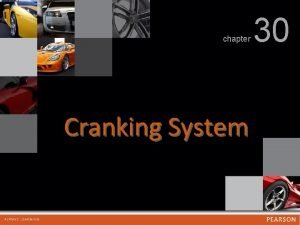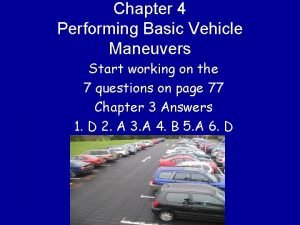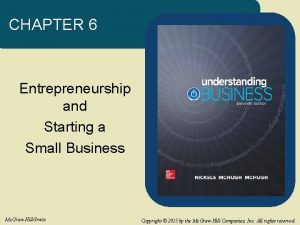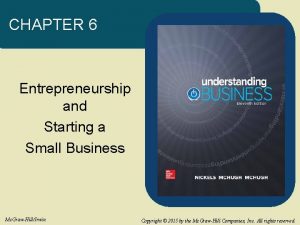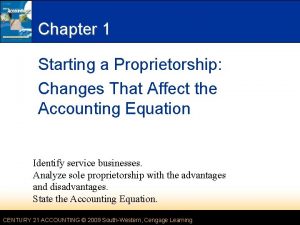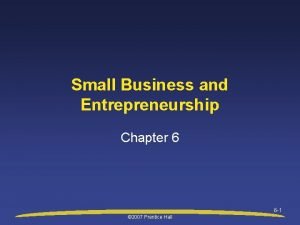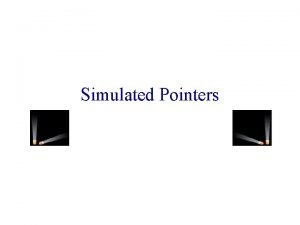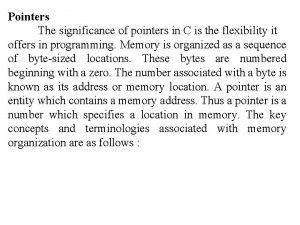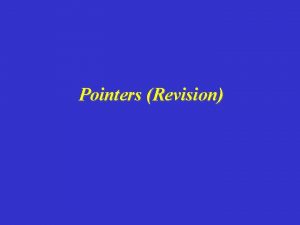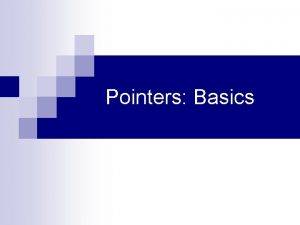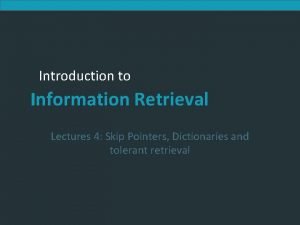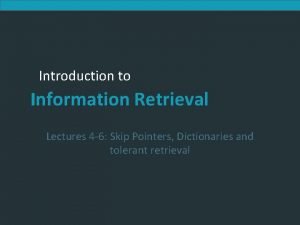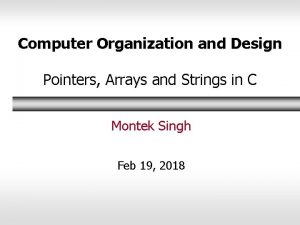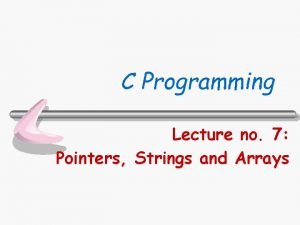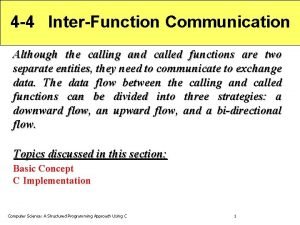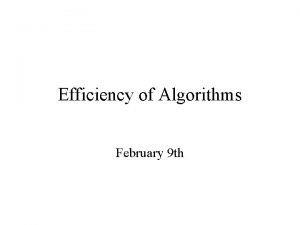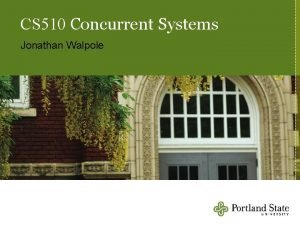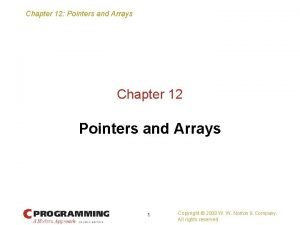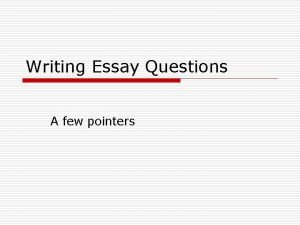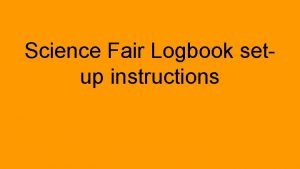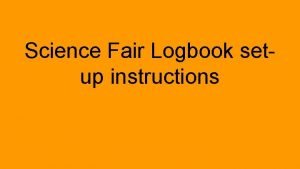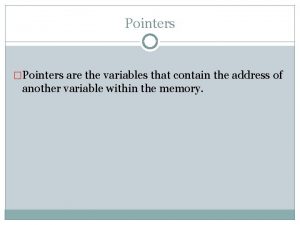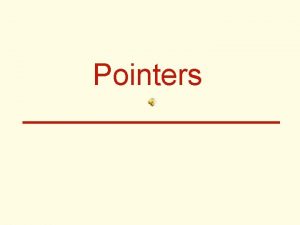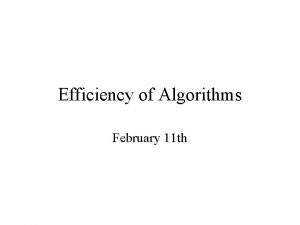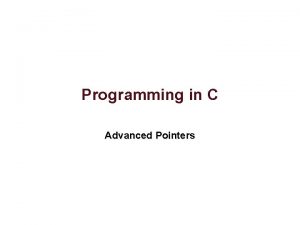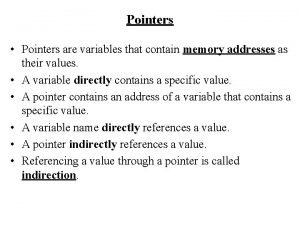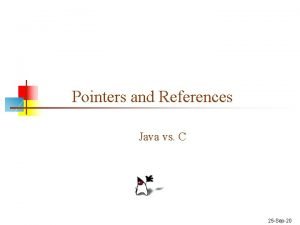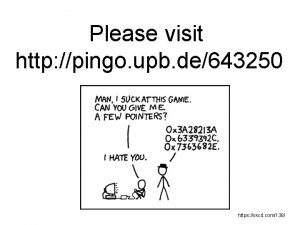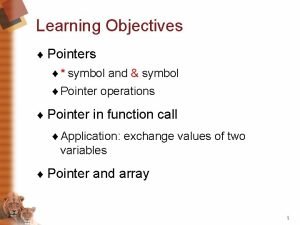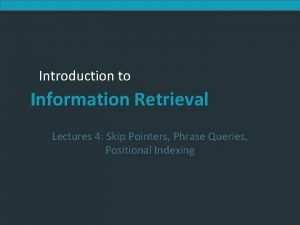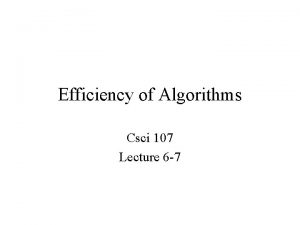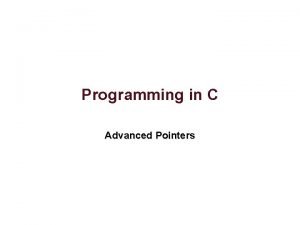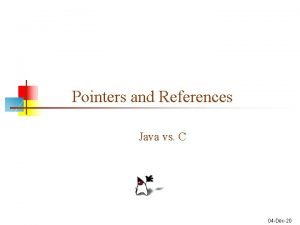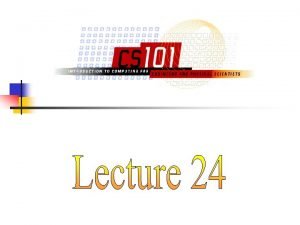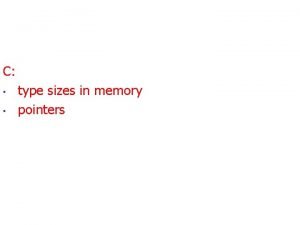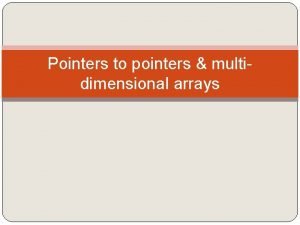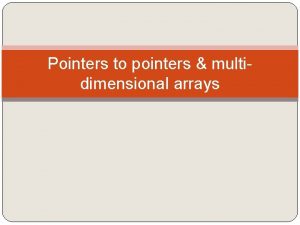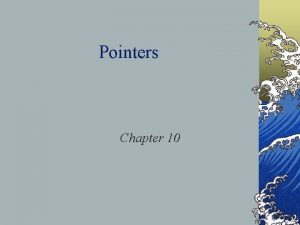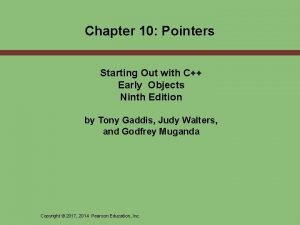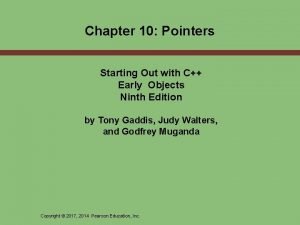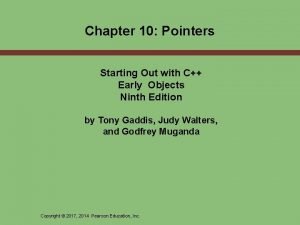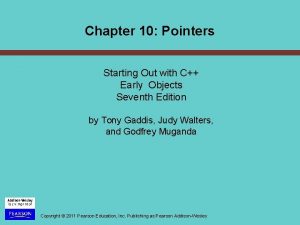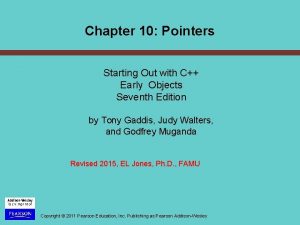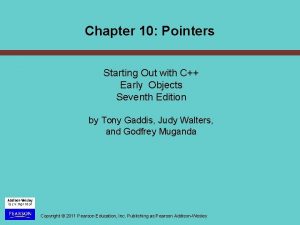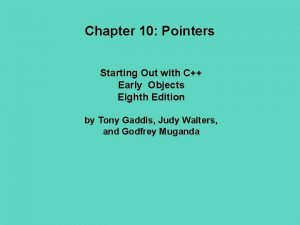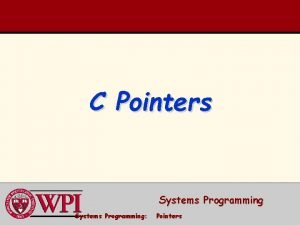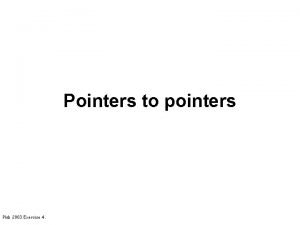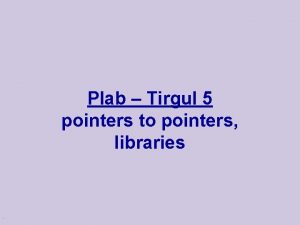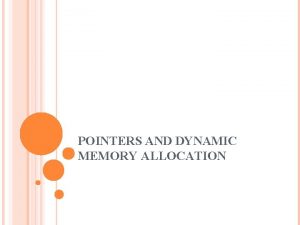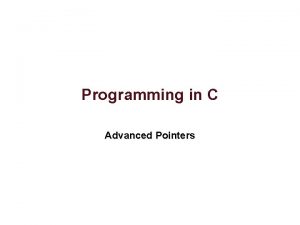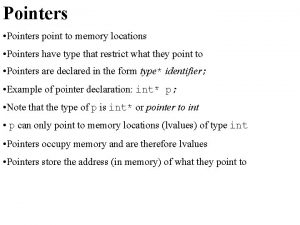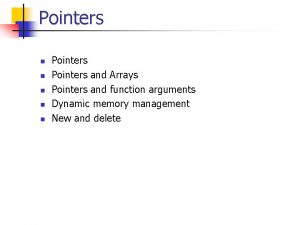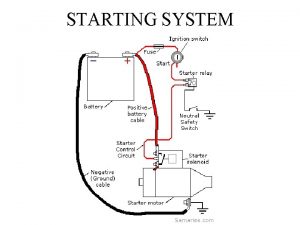Chapter 10 Pointers Starting Out with C Early









![Pointers in Expressions • Given: int vals[]={4, 7, 11}; int *valptr = vals; • Pointers in Expressions • Given: int vals[]={4, 7, 11}; int *valptr = vals; •](https://slidetodoc.com/presentation_image_h2/7a59ca6619753cb6eb0c17e3ad6cb3c5/image-10.jpg)

![Array Access • Array notation vals[i] is equivalent to the pointer notation *(vals + Array Access • Array notation vals[i] is equivalent to the pointer notation *(vals +](https://slidetodoc.com/presentation_image_h2/7a59ca6619753cb6eb0c17e3ad6cb3c5/image-12.jpg)

![Pointer Arithmetic Assume the variable definitions int vals[]={4, 7, 11}; int *valptr = vals; Pointer Arithmetic Assume the variable definitions int vals[]={4, 7, 11}; int *valptr = vals;](https://slidetodoc.com/presentation_image_h2/7a59ca6619753cb6eb0c17e3ad6cb3c5/image-14.jpg)
![More on Pointer Arithmetic Assume the variable definitions: int vals[]={4, 7, 11}; int *valptr More on Pointer Arithmetic Assume the variable definitions: int vals[]={4, 7, 11}; int *valptr](https://slidetodoc.com/presentation_image_h2/7a59ca6619753cb6eb0c17e3ad6cb3c5/image-15.jpg)
![More on Pointer Arithmetic Assume the variable definitions: int vals[]={4, 7, 11}; int *valptr More on Pointer Arithmetic Assume the variable definitions: int vals[]={4, 7, 11}; int *valptr](https://slidetodoc.com/presentation_image_h2/7a59ca6619753cb6eb0c17e3ad6cb3c5/image-16.jpg)
![More on Pointer Arithmetic Assume the variable definitions int vals[] = {4, 7, 11}; More on Pointer Arithmetic Assume the variable definitions int vals[] = {4, 7, 11};](https://slidetodoc.com/presentation_image_h2/7a59ca6619753cb6eb0c17e3ad6cb3c5/image-17.jpg)

























- Slides: 42

Chapter 10: Pointers Starting Out with C++ Early Objects Eighth Edition by Tony Gaddis, Judy Walters, and Godfrey Muganda Copyright © 2014, 2008 Pearson Education, Inc. Publishing as Pearson Addison-Wesley

Topics 10. 1 Pointers and the Address Operator 10. 2 Pointer Variables 10. 3 The Relationship Between Arrays and Pointers 10. 4 Pointer Arithmetic 10. 5 Initializing Pointers 10. 6 Comparing Pointers Copyright © 2014, 2008 Pearson Education, Inc. Publishing as Pearson Addison-Wesley 10 -2

Topics (continued) 10. 7 Pointers as Function Parameters 10. 8 Pointers to Constants and Constant Pointers 10. 9 Dynamic Memory Allocation 10. 10 Returning Pointers from Functions 10. 11 Pointers to Class Objects and Structures 10. 12 Selecting Members of Objects Copyright © 2014, 2008 Pearson Education, Inc. Publishing as Pearson Addison-Wesley 10 -3

10. 1 Pointers and the Address Operator • Each variable in a program is stored at a unique location in memory that has an address • Use the address operator & to get the address of a variable: int num = -23; cout << # // prints address // in hexadecimal • The address of a memory location is a pointer Copyright © 2014, 2008 Pearson Education, Inc. Publishing as Pearson Addison-Wesley 10 -4

10. 2 Pointer Variables • Pointer variable (pointer): a variable that holds an address • Pointers provide an alternate way to access memory locations Copyright © 2014, 2008 Pearson Education, Inc. Publishing as Pearson Addison-Wesley 10 -5

Pointer Variables • Definition: int *intptr; • Read as: “intptr can hold the address of an int” or “the variable that intptr points to has type int” • The spacing in the definition does not matter: int * intptr; int* intptr; • * is called the indirection operator Copyright © 2014, 2008 Pearson Education, Inc. Publishing as Pearson Addison-Wesley 10 -6

Pointer Variables • Assignment: int num = 25; int *intptr; intptr = # • Memory layout: num intptr 25 0 x 4 a 00 address of num: 0 x 4 a 00 • Can access num using intptr and indirection operator *: cout << intptr; // prints 0 x 4 a 00 cout << *intptr; // prints 25 *intptr = 20; // puts 20 in num Copyright © 2014, 2008 Pearson Education, Inc. Publishing as Pearson Addison-Wesley 10 -7

10. 3 The Relationship Between Arrays and Pointers An array name is the starting address of the array int vals[] = {4, 7, 11}; 4 7 11 starting address of vals: 0 x 4 a 00 cout << vals; // displays 0 x 4 a 00 cout << vals[0]; // displays 4 Copyright © 2014, 2008 Pearson Education, Inc. Publishing as Pearson Addison-Wesley 10 -8

The Relationship Between Arrays and Pointers • An array name can be used as a pointer constant int vals[] = {4, 7, 11}; cout << *vals; // displays 4 • A pointer can be used as an array name int *valptr = vals; cout << valptr[1]; // displays 7 Copyright © 2014, 2008 Pearson Education, Inc. Publishing as Pearson Addison-Wesley 10 -9
![Pointers in Expressions Given int vals4 7 11 int valptr vals Pointers in Expressions • Given: int vals[]={4, 7, 11}; int *valptr = vals; •](https://slidetodoc.com/presentation_image_h2/7a59ca6619753cb6eb0c17e3ad6cb3c5/image-10.jpg)
Pointers in Expressions • Given: int vals[]={4, 7, 11}; int *valptr = vals; • What is valptr + 1? • It means (address in valptr) + (1 * size of an int) cout << *(valptr+1); // displays 7 cout << *(valptr+2); // displays 11 • Must use ( ) in expression Copyright © 2014, 2008 Pearson Education, Inc. Publishing as Pearson Addison-Wesley 10 -10

Array Access Array elements can be accessed in many ways Array access method Example array name and [ ] vals[2] = 17; pointer to array and [ ] valptr[2] = 17; array name and subscript arithmetic *(vals+2) = 17; pointer to array and subscript arithmetic *(valptr+2) = 17; Copyright © 2014, 2008 Pearson Education, Inc. Publishing as Pearson Addison-Wesley 10 -11
![Array Access Array notation valsi is equivalent to the pointer notation vals Array Access • Array notation vals[i] is equivalent to the pointer notation *(vals +](https://slidetodoc.com/presentation_image_h2/7a59ca6619753cb6eb0c17e3ad6cb3c5/image-12.jpg)
Array Access • Array notation vals[i] is equivalent to the pointer notation *(vals + i) • No bounds checking is performed on array access Copyright © 2014, 2008 Pearson Education, Inc. Publishing as Pearson Addison-Wesley 10 -12

10. 4 Pointer Arithmetic Some arithmetic operators can be used with pointers: – Increment and decrement operators ++, -– Integers can be added to or subtracted from pointers using the operators +, -, +=, and -= – One pointer can be subtracted from another by using the subtraction operator - Copyright © 2014, 2008 Pearson Education, Inc. Publishing as Pearson Addison-Wesley 10 -13
![Pointer Arithmetic Assume the variable definitions int vals4 7 11 int valptr vals Pointer Arithmetic Assume the variable definitions int vals[]={4, 7, 11}; int *valptr = vals;](https://slidetodoc.com/presentation_image_h2/7a59ca6619753cb6eb0c17e3ad6cb3c5/image-14.jpg)
Pointer Arithmetic Assume the variable definitions int vals[]={4, 7, 11}; int *valptr = vals; Examples of use of ++ and -valptr++; // points at 7 valptr--; // now points at 4 Copyright © 2014, 2008 Pearson Education, Inc. Publishing as Pearson Addison-Wesley 10 -14
![More on Pointer Arithmetic Assume the variable definitions int vals4 7 11 int valptr More on Pointer Arithmetic Assume the variable definitions: int vals[]={4, 7, 11}; int *valptr](https://slidetodoc.com/presentation_image_h2/7a59ca6619753cb6eb0c17e3ad6cb3c5/image-15.jpg)
More on Pointer Arithmetic Assume the variable definitions: int vals[]={4, 7, 11}; int *valptr = vals; Example of the use of + to add an int to a pointer: cout << *(valptr + 2) This statement will print 11 Copyright © 2014, 2008 Pearson Education, Inc. Publishing as Pearson Addison-Wesley 10 -15
![More on Pointer Arithmetic Assume the variable definitions int vals4 7 11 int valptr More on Pointer Arithmetic Assume the variable definitions: int vals[]={4, 7, 11}; int *valptr](https://slidetodoc.com/presentation_image_h2/7a59ca6619753cb6eb0c17e3ad6cb3c5/image-16.jpg)
More on Pointer Arithmetic Assume the variable definitions: int vals[]={4, 7, 11}; int *valptr = vals; Example of use of +=: valptr = vals; // points at 4 valptr += 2; // points at 11 Copyright © 2014, 2008 Pearson Education, Inc. Publishing as Pearson Addison-Wesley 10 -16
![More on Pointer Arithmetic Assume the variable definitions int vals 4 7 11 More on Pointer Arithmetic Assume the variable definitions int vals[] = {4, 7, 11};](https://slidetodoc.com/presentation_image_h2/7a59ca6619753cb6eb0c17e3ad6cb3c5/image-17.jpg)
More on Pointer Arithmetic Assume the variable definitions int vals[] = {4, 7, 11}; int *valptr = vals; Example of pointer subtraction valptr += 2; cout << valptr - val; This statement prints 2: the number of ints between valptr and val Copyright © 2014, 2008 Pearson Education, Inc. Publishing as Pearson Addison-Wesley 10 -17

10. 5 Initializing Pointers • Can initialize to NULL or 0 (zero) int *ptr = NULL; • Can initialize to addresses of other variables int num, *num. Ptr = # int val[ISIZE], *valptr = val; • Initial value must have correct type float cost; int *ptr = &cost; // won't work Copyright © 2014, 2008 Pearson Education, Inc. Publishing as Pearson Addison-Wesley 10 -18

10. 6 Comparing Pointers • Relational operators can be used to compare addresses in pointers • Comparing addresses in pointers is not the same as comparing contents pointed at by pointers: if (ptr 1 == ptr 2) // // if (*ptr 1 == *ptr 2) // // compares addresses compares contents Copyright © 2014, 2008 Pearson Education, Inc. Publishing as Pearson Addison-Wesley 10 -19

10. 7 Pointers as Function Parameters • A pointer can be a parameter • It works like a reference parameter to allow changes to argument from within a function • A pointer parameter must be explicitly dereferenced to access the contents at that address Copyright © 2014, 2008 Pearson Education, Inc. Publishing as Pearson Addison-Wesley 10 -20

Pointers as Function Parameters Requires: 1) asterisk * on parameter in prototype and heading void get. Num(int *ptr); 2) asterisk * in body to dereference the pointer cin >> *ptr; 3) address as argument to the function in the call get. Num(&num); Copyright © 2014, 2008 Pearson Education, Inc. Publishing as Pearson Addison-Wesley 10 -21

Pointers as Function Parameters void swap(int *x, int *y) { int temp; temp = *x; *x = *y; *y = temp; } int num 1 = 2, num 2 = -3; swap(&num 1, &num 2); //call Copyright © 2014, 2008 Pearson Education, Inc. Publishing as Pearson Addison-Wesley 10 -22

10. 8 Ponters to Constants and Constant Pointers • Pointer to a constant: cannot change the value that is pointed at • Constant pointer: the address in the pointer cannot change after the pointer is initialized Copyright © 2014, 2008 Pearson Education, Inc. Publishing as Pearson Addison-Wesley 10 -23

Ponters to Constant • Must use const keyword in pointer definition: const double tax. Rates[] = {0. 65, 0. 8, 0. 75}; const double *rate. Ptr; • Use const keyword for pointers in function headers to protect data from modification from within function Copyright © 2014, 2008 Pearson Education, Inc. Publishing as Pearson Addison-Wesley 10 -24

Pointer to Constant – What does the Definition Mean? Read as: “rates is a pointer to a constant that is a double. ” Copyright © 2014, 2008 Pearson Education, Inc. Publishing as Pearson Addison-Wesley 10 -25

Constant Pointers • Defined with const keyword adjacent to variable name: int class. Size = 24; int * const class. Ptr = &class. Size; • Must be initialized when defined • Can be used without initialization as a function parameter – Initialized by argument when function is called – Function can receive different arguments on different calls • While the address in the pointer cannot change, the data at that address may be changed Copyright © 2014, 2008 Pearson Education, Inc. Publishing as Pearson Addison-Wesley 10 -26

Constant Pointer – What does the Definition Mean? Read as: “pts is a constant pointer to an int. ” Copyright © 2014, 2008 Pearson Education, Inc. Publishing as Pearson Addison-Wesley 10 -27

Constant Pointer to Constant • Can combine pointer to constants and constant pointers: int size = 10; const int * const ptr = &size; • What does it mean? Copyright © 2014, 2008 Pearson Education, Inc. Publishing as Pearson Addison-Wesley 10 -28

10. 9 Dynamic Memory Allocation • Can allocate storage for a variable while program is running • Uses new operator to allocate memory double *dptr; dptr = new double; • new returns address of memory location Copyright © 2014, 2008 Pearson Education, Inc. Publishing as Pearson Addison-Wesley 10 -29

Dynamic Memory Allocation • Can also use new to allocate array. Ptr = new double[25]; – Program may terminate if there is not sufficient memory • Can then use [ ] or pointer arithmetic to access array Copyright © 2014, 2008 Pearson Education, Inc. Publishing as Pearson Addison-Wesley 10 -30

Dynamic Memory Example int *count, *arrayptr; count = new int; cout <<"How many students? "; cin >> *count; arrayptr = new int[*count]; for (int i=0; i<*count; i++) { cout << "Enter score " << i << ": "; cin >> arrayptr[i]; } Copyright © 2014, 2008 Pearson Education, Inc. Publishing as Pearson Addison-Wesley 10 -31

Releasing Dynamic Memory • Use delete to free dynamic memory delete count; • Use delete [] to free dynamic array memory delete [] arrayptr; • Only use delete with dynamic memory! Copyright © 2014, 2008 Pearson Education, Inc. Publishing as Pearson Addison-Wesley 10 -32

Dangling Pointers and Memory Leaks • A pointer is dangling if it contains the address of memory that has been freed by a call to delete. – Solution: set such pointers to 0 as soon as memory is freed. • A memory leak occurs if no-longer-needed dynamic memory is not freed. The memory is unavailable for reuse within the program. – Solution: free up dynamic memory after use Copyright © 2014, 2008 Pearson Education, Inc. Publishing as Pearson Addison-Wesley 10 -33

10. 10 Returning Pointers from Functions • Pointer can be return type of function int* new. Num(); • The function must not return a pointer to a local variable in the function • The function should only return a pointer – to data that was passed to the function as an argument – to dynamically allocated memory Copyright © 2014, 2008 Pearson Education, Inc. Publishing as Pearson Addison-Wesley 10 -34

10. 11 Pointers to Class Objects and Structures • Can create pointers to objects and structure variables struct Student {…}; class Square {…}; Student stu 1; Student *stu. Ptr = &stu 1; Square sq 1[4]; Square *square. Ptr = &sq 1[0]; • Need to use() when using * and. operators (*stu. Ptr). student. ID = 12204; Copyright © 2014, 2008 Pearson Education, Inc. Publishing as Pearson Addison-Wesley 10 -35

Structure Pointer Operator • Simpler notation than (*ptr). member • Use the form ptr->member: stu. Ptr->student. ID = 12204; square. Ptr->set. Side(14); in place of the form (*ptr). member: (*stu. Ptr). student. ID = 12204; (*square. Ptr). set. Side(14); Copyright © 2014, 2008 Pearson Education, Inc. Publishing as Pearson Addison-Wesley 10 -36

Dynamic Memory with Objects • Can allocate dynamic structure variables and objects using pointers: stu. Ptr = new Student; • Can pass values to constructor: square. Ptr = new Square(17); • delete causes destructor to be invoked: delete square. Ptr; Copyright © 2014, 2008 Pearson Education, Inc. Publishing as Pearson Addison-Wesley 10 -37

Structure/Object Pointers as Function Parameters • Pointers to structures or objects can be passed as parameters to functions • Such pointers provide a pass-by-reference parameter mechanism • Pointers must be dereferenced in the function to access the member fields Copyright © 2014, 2008 Pearson Education, Inc. Publishing as Pearson Addison-Wesley 10 -38

Controlling Memory Leaks • Memory that is allocated with new should be deallocated with a call to delete as soon as the memory is no longer needed. This is best done in the same function as the one that allocated the memory. • For dynamically-created objects, new should be used in the constructor and delete should be used in the destructor Copyright © 2014, 2008 Pearson Education, Inc. Publishing as Pearson Addison-Wesley 10 -39

10. 12 Selecting Members of Objects Situation: A structure/object contains a pointer as a member. There is also a pointer to the structure/ object. Problem: How do we access the pointer member via the structure/object pointer? struct Grade. List { string course. Num; int * grades; } Grade. List test 1, *test. Ptr = &test 1; Copyright © 2014, 2008 Pearson Education, Inc. Publishing as Pearson Addison-Wesley 10 -40

Selecting Members of Objects Expression Meaning test. Ptr->grades Access the grades pointer in test 1. This is the same as (*test. Ptr). grades *test. Ptr->grades Access the value pointed at by test. Ptr->grades. This is the same as *(*test. Ptr). grades *test 1. grades Access the value pointed at by test 1. grades Copyright © 2014, 2008 Pearson Education, Inc. Publishing as Pearson Addison-Wesley 10 -41

Chapter 10: Pointers Starting Out with C++ Early Objects Eighth Edition by Tony Gaddis, Judy Walters, and Godfrey Muganda Copyright © 2014, 2008 Pearson Education, Inc. Publishing as Pearson Addison-Wesley
 Personification in the song one thing by one direction
Personification in the song one thing by one direction Early cpr and early defibrillation can: *
Early cpr and early defibrillation can: * Chapter 30 engine starting systems
Chapter 30 engine starting systems Chapter 4 drive right answers
Chapter 4 drive right answers Chapter 6 entrepreneurship and starting a small business
Chapter 6 entrepreneurship and starting a small business Chapter 6 entrepreneurship and starting a small business
Chapter 6 entrepreneurship and starting a small business Chapter 6 entrepreneurship and starting a small business
Chapter 6 entrepreneurship and starting a small business Chapter 1 starting a proprietorship
Chapter 1 starting a proprietorship Small busness loans
Small busness loans Caedb
Caedb Significance of pointer
Significance of pointer C array of pointers to structs
C array of pointers to structs Xp1024xp
Xp1024xp Skip pointer
Skip pointer Skip pointers
Skip pointers Which is a good idea for using skip pointers
Which is a good idea for using skip pointers Explicit pointers
Explicit pointers Pointers and strings
Pointers and strings Java pointers
Java pointers Inter function communication
Inter function communication Swizzling glsl
Swizzling glsl Shuffle left algorithm
Shuffle left algorithm Hazard pointers
Hazard pointers 12 pointers
12 pointers I-need-a-few-pointers-98hpou5
I-need-a-few-pointers-98hpou5 I-need-a-few-pointers-98hpou5
I-need-a-few-pointers-98hpou5 Scientific logbook example
Scientific logbook example Pointers are variables that contain
Pointers are variables that contain What is the fundamental of pointers?
What is the fundamental of pointers? Pointers are variables that contain as their values
Pointers are variables that contain as their values Converging pointers algorithm
Converging pointers algorithm Advanced pointers in c
Advanced pointers in c Constant pointer and pointer to constant
Constant pointer and pointer to constant Pointers are variables that contain as their values
Pointers are variables that contain as their values & vs * in c
& vs * in c Xkcd
Xkcd Pointers symbol
Pointers symbol Skip pointers
Skip pointers Shuffle left algorithm
Shuffle left algorithm Advanced pointers in c
Advanced pointers in c & vs * in c
& vs * in c File pointers in c
File pointers in c Pointers in assembly
Pointers in assembly


